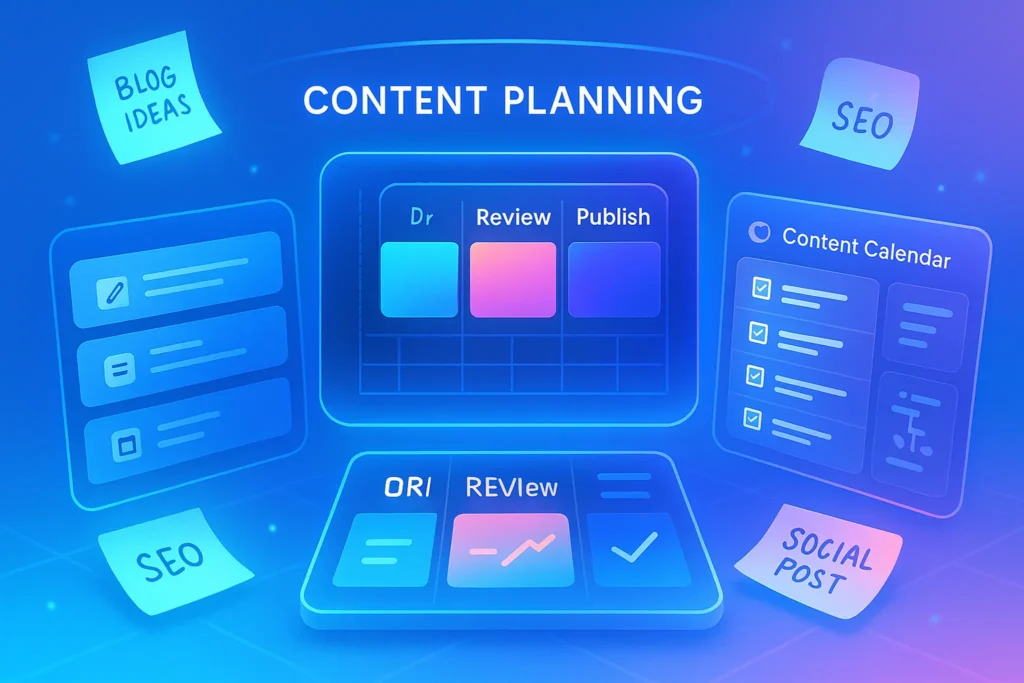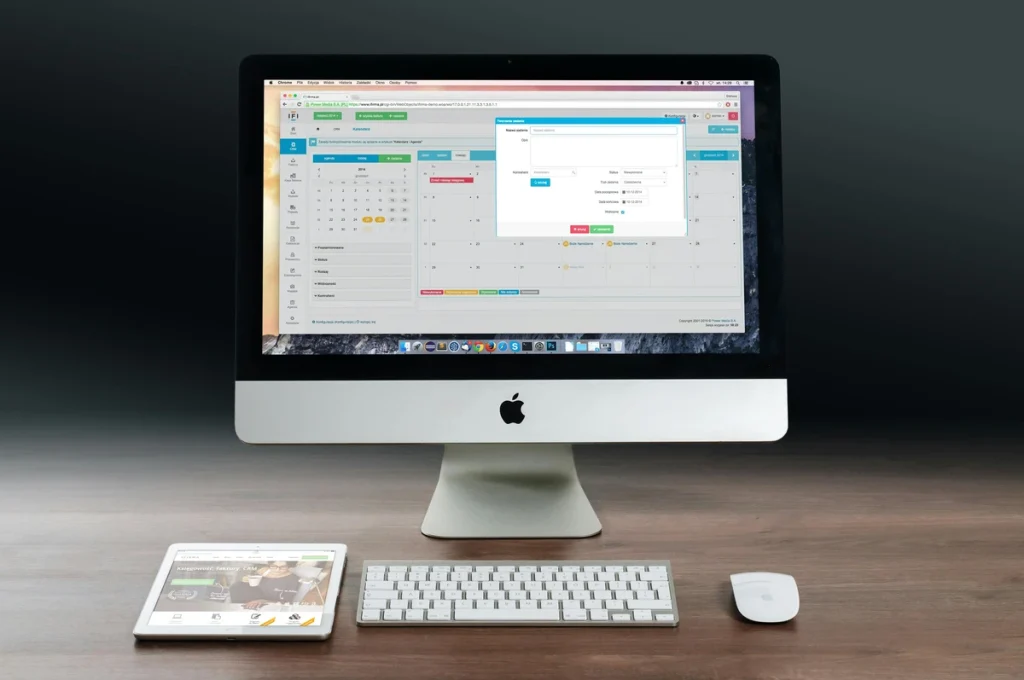-This post may contain affiliate links. If you click on one and make a purchase, I may earn a small commission at no extra cost to you.-
🪝 Introduction:
Content chaos kills consistency.
You’re constantly juggling blog posts, social media campaigns, newsletters, and maybe even a YouTube channel. Without a system, it’s just noise and missed deadlines.
In 2025, top marketers don’t just “wing it.” They run structured content machines powered by smart platforms.
In this guide, we’ll dive into:
-
Why having a content calendar is non-negotiable
-
Step-by-step: How to build your own content calendar
-
Top software platforms (like Trello, Notion, CoSchedule, and more) — with real use cases
-
Bonus: A free PDF + Airtable template you can grab and start today
And if you’re serious about automating content production, don’t miss our deep dive on AI Tools to Launch a Blog — a natural next step after setting up your content system.
🧩 Why You Need a Content Calendar
Without a structured calendar, content production becomes reactive instead of strategic. You might post sporadically, miss important dates, or overload some channels while neglecting others.
A content calendar gives you a system to work from. It helps align your marketing goals with what gets published, keeps your team accountable, and allows for better performance tracking. You’re not just planning content — you’re creating a content engine that scales.
Content isn’t just writing. It’s strategy, consistency, and visibility. A content calendar helps you:
-
Visualize your roadmap across all platforms
-
Align your team or freelancers with clear deadlines
-
Maintain publishing consistency (especially important for SEO and social growth)
-
Track what works and what flops
A good calendar doesn’t just show what to post. It helps you remember why you’re posting it in the first place.
If you’re managing more than one content channel, a calendar turns into your command center.
And platforms like Monday.com or Airtable can take this from chaos to clarity.
🛠️ How to Build an Effective Content Calendar (Step-by-Step)
Before we get to the tools, let’s break down how to actually build a content calendar from scratch. This gives you the logic behind what those platforms are designed to help you with.
✅ Step 1: Define Your Content Channels
Start by identifying all the platforms where your brand shows up. This might include your blog, LinkedIn, Instagram, YouTube, newsletter, podcast, and more.
Separate these into two types: Owned channels (like your website or email list) and Rented channels (like social media). This distinction helps prioritize where you have full control and where you’re subject to algorithm changes. Knowing your exact footprint is essential before any content planning begins.
Start by listing out where you publish content. Typical examples:
-
Blog
-
LinkedIn
-
Instagram
-
Email newsletter
-
YouTube
You can use a simple table or Airtable base to map these out.
✅ Step 2: Set Your Publishing Frequency
Publishing frequency isn’t just about volume — it’s about building rhythm and expectation. When you post consistently, platforms reward you with better reach, and your audience builds a habit around your content.
But consistency doesn’t mean posting daily everywhere. Start with what’s sustainable for your resources. Use your frequency goals to reverse-engineer your content needs for the month. This clarity helps prevent burnout while keeping momentum high.
Define how often you’ll post on each channel. Be realistic but consistent.
| Channel | Frequency |
|---|---|
| Blog | 3x per week |
| Daily | |
| 2x per week | |
| Weekly |
Having this clear helps you reverse-engineer how much content you need to prepare ahead.
✅ Step 3: Choose Content Categories (a.k.a. Pillars)
Content pillars are the strategic themes your brand consistently talks about. They help you stay focused, organized, and memorable. For example, a health brand might use pillars like Nutrition Tips, Workouts, Mindset, and Supplements.
Having 3–5 strong pillars makes ideation faster and ensures content variety without losing brand voice. You’ll also find it easier to repurpose content when everything ties back to a few consistent themes.
Group your content into categories to avoid posting random stuff. For example:
-
🧠 Educational (How-tos, tips)
-
💼 Product-related (Feature launches, behind-the-scenes)
-
🤝 Community (Testimonials, partnerships)
This will later help when tagging content in tools like Trello, Asana, or ClickUp.
✅ Step 4: Plan Topics 2–4 Weeks Ahead
Planning topics in advance gives you creative breathing room. It allows you to align with upcoming campaigns, seasonal trends, or even holidays. It also keeps your production team on track with deadlines and avoids last-minute scrambles.
A 2–4 week buffer is ideal — it’s long enough to be proactive, but short enough to stay flexible. Use tools like Google Trends, community forums, or AI ideation tools to fill in your calendar without overthinking it.
Now that you have channels, frequency, and pillars — you can brainstorm actual topics.
Use a tool like Google Trends, or check out our AI automation guide to generate ideas faster with tools like Jasper or ChatGPT.
Once you have a topic bank, you can drag-and-drop them across your content calendar.
✅ Step 5: Choose a Platform to Visualize & Track
The right platform turns your content plan from a static list into a living system. Visual tools like Trello help you see workflows at a glance. Airtable gives you powerful database functionality, while Notion lets you blend content tracking with internal documentation.
For teams, tools like Monday.com or CoSchedule offer deeper automation, notifications, and multi-channel tracking. Pick a tool that fits your workflow — not the other way around. What matters most is clarity, collaboration, and visibility.
Now comes the fun part: choosing the right tool to map this into a living system.
Some people love visual boards (like Trello). Others prefer powerful databases (like Notion or Airtable).
Don’t worry — we’ll break each one down next.
But first…
🧰 Free Content Calendar Toolkit
Want to turn your content chaos into a clear publishing system? Get our 10-template toolkit + bonus PDF to plan 6 months of content in 1 hour.
- ✔ 10 Ready-to-Use Templates
- ✔ Airtable Base + Editorial Planner
- ✔ Instant Download + Email Tips
🔐 100% privacy. No noise. Just value-packed content tips from NerdChips.
🚀 Top Content Marketing Platforms
1. CoSchedule – Best All-in-One for Content Teams
CoSchedule isn’t just a calendar — it’s a full content marketing management suite built for teams.
With its Marketing Calendar and Marketing Suite, you can:
-
Plan blog posts, social campaigns, emails, and events in one place
-
Create workflows for each team member
-
Use “Best Time Scheduling” to auto-optimize publish times
-
Get a complete bird’s-eye view of everything — no spreadsheet needed
Why You Should Use It:
If you manage a team or multiple content types (social + blog + email), CoSchedule centralizes it all. Their ReQueue feature even automatically recycles top content to fill gaps in your schedule.
✅ Works great for agencies and remote teams
✅ Native WordPress + HubSpot + Mailchimp integration
📌 Nerd Tip: Their free marketing calendar is enough to start, but their paid suite comes with team collaboration and analytics. You can try both via their 14-day trial.
💡 Naturally connects to our post on AI Tools to Launch a Blog — combine AI writing tools with CoSchedule to build a system that runs itself.
2. Trello – Best for Visual Thinkers
If you’re a Kanban-lover, Trello is your canvas.
Create a card for each post or asset. Use labels for content categories (Blog, YouTube, X), due dates for deadlines, and checklists for tasks like draft > review > publish.
Great for:
-
Solo content creators or small teams
-
Visualizing stages of production (Drafting, Editing, Publishing)
-
Integrating with Google Drive, Slack, and more
🌱 It’s free, easy to start, and perfect for visual planning.
Want to go deeper? We cover how to connect Trello to automation tools like Zapier in our AI-powered planning guide.
3. Asana – Best for Task-Driven Teams
Asana turns content calendars into projects with deadlines, roles, and dependencies.
For each content piece, you can:
-
Assign owners
-
Set due dates
-
Add subtasks (keyword research, writing, editing, promotion)
-
Attach files, notes, and comments
Best for teams that already use Asana for task management and want to integrate content production into their operational flow.
🧩 Pro users can build calendar and board views + custom fields for tags and pillars.
4. ClickUp – Best for Custom Workflows
ClickUp is a productivity power tool with deep customization.
You can:
-
Build a content dashboard with custom views
-
Set automated reminders for drafts, design, publishing
-
Create checklists, statuses, and even embed content briefs
Their templates for content marketing are robust — from SEO content planning to cross-channel campaign tracking.
Perfect if you need more than just a calendar, and want it all in one place.
5. Notion – Best for Centralized Content Knowledge
Notion isn’t just for note-taking.
You can build a dynamic editorial database with filters for status, platform, category, and more.
Bonus: You can also store brand guidelines, content briefs, and editorial SOPs in the same workspace.
💡 Tip: Use the gallery view to replicate a visual calendar or connect with automation tools like Make (Integromat).
🔥 Many solo creators and agencies now run their entire content ops on Notion.
6. Monday.com – Best for Marketing Teams with Structure
Monday is a visual work management platform that works beautifully for content calendars.
It lets you:
-
Create boards per channel or team
-
Use templates like “Content Calendar,” “Campaign Tracker,” or “Blog Planning”
-
Automate reminders, status updates, and content assignments
-
Integrate with tools like Google Drive, Slack, and Outlook
If you’re interested in building a full marketing pipeline in Monday, don’t miss our dedicated guide on Monday Content Planning.
☀️ Highly recommended for cross-functional teams (SEO, Social, Email) who want everything visible and automated.
7. Airtable – Best for Spreadsheet Lovers Who Need Superpowers
Think of Airtable as a spreadsheet on steroids.
You get:
-
Custom views: calendar, kanban, grid
-
Linked databases (e.g. Blog Posts ↔ Authors ↔ Statuses)
-
Conditional coloring, filtering, and real-time collaboration
-
Automations + integrations with dozens of tools
Airtable is especially useful if you want data structure + calendar view + publishing logic — all in one.
📦 Our free Lead Magnet (below) includes a full Airtable base you can copy and use right away!
8. ContentStudio – Best for Social + Blog Combo
If your content marketing is heavily social-driven, ContentStudio is built for you.
Features include:
-
Multi-platform scheduler (X, Facebook, Instagram, LinkedIn, Pinterest)
-
Content discovery + AI suggestions
-
Blog + social integration in one calendar
-
Collaboration tools for teams
It’s a great mix of planning + automation with built-in content research.
🧠 Nerd Verdict
If you’re serious about content marketing, you need more than inspiration — you need structure, visibility, and repeatable systems.
Whether you’re managing a solo blog, a startup’s content funnel, or a team of marketers, the tools above let you move from chaos to clarity.
Here’s the breakdown:
-
Start free with Trello or Notion
-
Grow with ClickUp, Monday, or Airtable as your operations expand
-
Layer automation and AI to turn your system into a content engine
💥 And don’t forget: The biggest ROI comes when you pair great strategy + consistent execution + the right tools.
❓ FAQ: Nerds Ask, We Answer
💬 Would You Bite?
What platform are you using right now for content planning — and what’s your biggest frustration with it?
Let’s talk in the comments 👇 — we read every reply.



